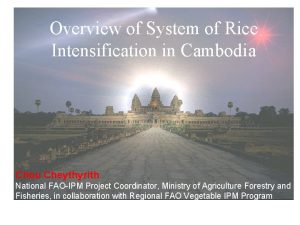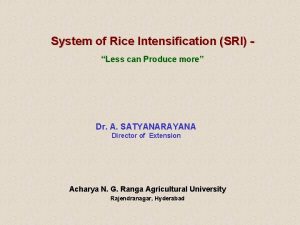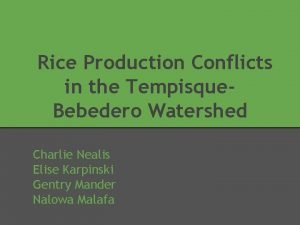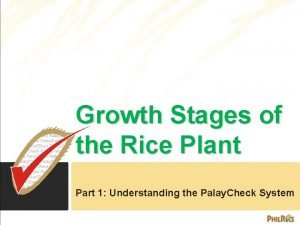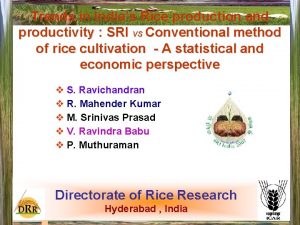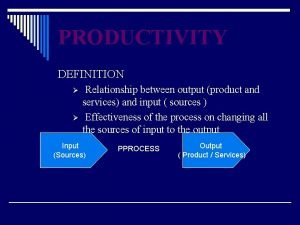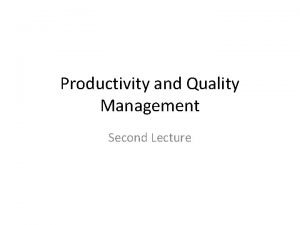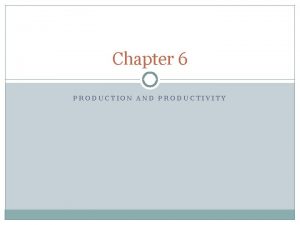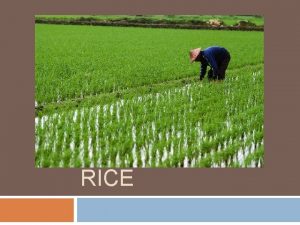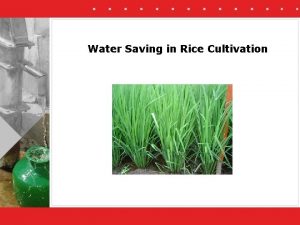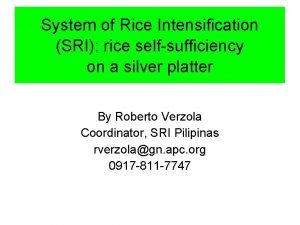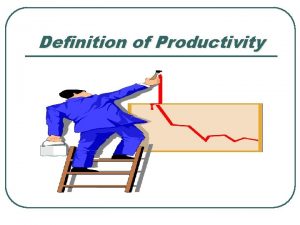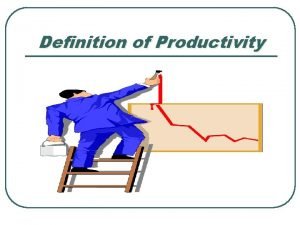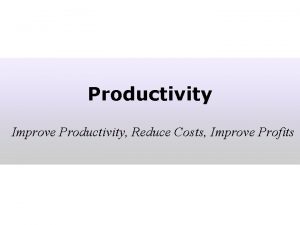Trends in Indias Rice production and productivity SRI












- Slides: 12

Trends in India’s Rice production and productivity : SRI vs Conventional method of rice cultivation - A statistical and economic perspective v S. Ravichandran v R. Mahender Kumar v M. Srinivas Prasad v V. Ravindra Babu v P. Muthuraman Directorate of Rice Research Hyderabad , India

Introduction Ø Rice is Life – 44% of population depends on rice. We need to produce 127 million tonnes by 2025 and 180 million tonnes by 2050.

Rice scenario

Year on Year Yield Improvement Year Yield increase (in kg) 1966 - 67 1 1988 - 89 224 1967 - 68 169 1989 - 90 56 1968 - 69 44 1991 - 92 11 1970 - 71 50 1993 - 94 144 1971 - 72 18 1994 - 95 23 1973 - 74 81 1996 - 97 85 1975 - 76 190 1997 - 98 18 1977 - 78 219 1998 - 99 21 1978 - 79 20 1999 – 00 65 1980 - 81 262 2001 - 02 178 1983 - 84 226 2003 - 04 333 1985 - 86 135 2005 - 06 118

Crop-wise water requirement S. No. Name of the crop Water Requirement (mm) 1 Rice 1240 2 Ragi 400 -450 3 Bajra 400 -550 4 Maize 400 -450 5 Groundnut 550 6 Wheat 450 -600 7 Cotton 650 -850 8 Sunflower 350 -500 9 Tobacco 300 -400

SRI over Conventional • “Water is the Elixir of Life”. Rice crop requires more water By SRI, in 10% area, if we save 20, 30 and 40% water, 500, 740 and 1000 million mm is saved. A huge amount of money saved. That means, additional 0. 4 mha rice can be grown or 2 -3 times of other cereals. Seed saving : 20 kg/ha Five times less hybrid seed is used – lower seed requirement in SRI. Less chemical fertiliser in SRI. No chemical control of pests and diseases. More Yield in SRI

Cost of Cultivation S. No. Activity Cost in Conventional Rupees SRI 1. 2. Nursery Preparation Main Field preparation 2110 2005 681 2005 3. 4. 5. 6. 7. 8. Nutrient Management Transplanting Weed Management Water Management Plant Protection Harvesting 7254 2400 3200 300 660 3500 7254 3200 1520 240 660 3500 Total 21, 249 19, 060

Cost of Cultivation (activity-wise)

Benefit Analysis S. No. Item SRI Conventional 1. Yield 7. 1 t/ha 6. 7 t/ha 2. Gross Return (per ha) Rs. 39050 Rs. 36850 3. B: C ratio 2. 04 : 1 1. 73 : 1 SRI is beneficial to farmers. By converting, 10% area under SRI, saving of RS. 43 million/season

Potential Yield Improvement under SRI S. No. Area under SRI (%) Yield Improvement (%) Inc. in rice production (million tons) 1 10 10 0. 31 2 10 20 0. 62 3 20 10 3. 47 4 20 20 6. 94 5 30 10 7. 80 6 30 20 15. 60 7 40 10 13. 87 8 40 20 27. 73

Conclusions and Recommendations SRI method is the solution for increase in rice production and productivity. Resources like water, seed, chemical ferilizers can be saved. Increased production, productivity and benefit cost ration by adopting SRI. Large scale adoption may be recommended by policy advisors to meet food security with lower resources.

References 1. S. Ravichandran and P. Hemasankari (2006) “Water: The elixir of life”, Kisan World, December 2006. 2. Fausett, L. (1994). Fundamentals of Neural Networks, New York: Prentice Hall. 3. M. S. Swaminathan (2006) Report of sub-committee on more crop and income per drop of water. 4. International Rice Research Institute (2001) Annual reports, 2000 -01: Rice Research: the way forward, IRRI, Las Banos, Phillippines. 5. T. M. Thiyagarajan, H. Hengsdijk, and Brindaban (2005) Transitions in agriculture for enhancing water productivity – Proc. of an Int. symposium, TNAU, TNadu.
 Sri rama sri rama sri manoharama
Sri rama sri rama sri manoharama Multimedia content production adalah
Multimedia content production adalah Sri system of rice intensification
Sri system of rice intensification Sri system of rice intensification
Sri system of rice intensification Sri system of rice intensification
Sri system of rice intensification Rice plant growth stages
Rice plant growth stages Sri system of rice intensification
Sri system of rice intensification Production and productivity definition
Production and productivity definition Define productivity
Define productivity Indias religions
Indias religions Indias religions
Indias religions What is indias main religion
What is indias main religion Indias first empire
Indias first empire


